|
|
|
Hansen's Northwest Native Plant Database |
|
|
|
Oemleria cerasiformis (Indian Plum, Oso Berry, Bird Cherry, Skunk Bush)
|
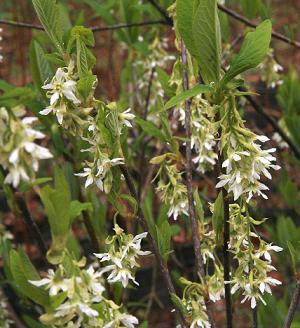 |
||||||||||||||||||||||||||||||||
|
|||||||||||||||||||||||||||||||||
|
Plant Brief: A harbinger of spring with pendant, greenish-white clusters of flowers in early March, Indian Plum grows rapidly to 15 - 20.' The many long, slender stems grow erect in full sun but in the dappled shade they arch majestically. The foliage is a cheerful lime green, turning yellow in autumn. In early summer, olive size, bittersweet, purple berries dot the branches but are almost immediately eaten by birds. Native groups collected the berries for eating. Indian Plum is found from BC to California, west of the Cascade Mountains, USDA zones 8-9. It prefers moist sites in full to partial shade but will survive in full sun. |
|||||||||||||||||||||||||||||||||
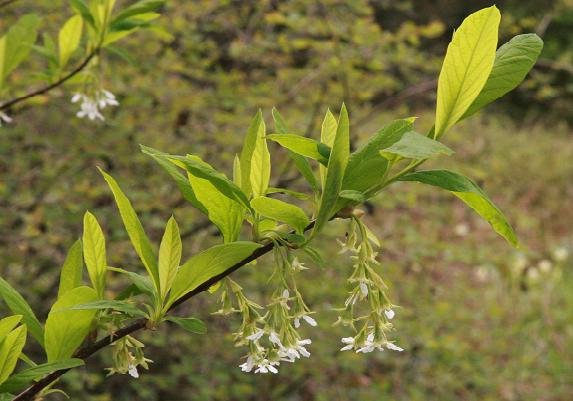 |
Description: Towards the end of the winter in the Pacific northwest we begin to lose hope of ever seeing a sunny day. Cheer has long been drowned in the endless rains, the cold damp has soaked its way into the soul. We long for a break in the clouds that will allow the sun to shine on our faces. Then the Indian Plum comes along with bright green leaves and creamy flowers a glimpse of spring amid the gray. The first deciduous native shrub in the Pacific northwest to flower, the Indian Plum is prized not only for its beauty but for the promise it conveys of longer days and lighter rains. |
||||||||||||||||||||||||||||||||
|
We celebrate our survival through the darkest, most introspective months. We greet the new cycle of growth, searching out further evidence of spring shoots poking through the dirt, birds darting and daring in their mating dances, fruit trees bursting into bud and silky pussy willows gracing the pond edges. |
|||||||||||||||||||||||||||||||||
|
Indian Plum is a tall shrub, reaching heights of five meters in optimal conditions. It grows tall and erect in sunny locations, but arches considerably in the shady spots it prefers. The branches grow from the central root system rather than growing outward from a trunk. The leaves are bright green, becoming darker as they age. They are 3 - 5 in length, oval and taper at the ends. As it is the first shrub to leaf out, so too is it the first shrub to change color. The leaves turn a pleasant, sunny yellow in early August, but hang on the bushes well into the autumn. This plant is dioecious, meaning that male and female flowers are found on separate plants. It is therefore not self-fruitful, relying on insects to perform pollination. The greenish-white flowers of the Indian Plum are very distinct. They hang pendulous in clusters (racemes) of 5 10 trumpet-shaped blossoms, each one only Ό to ½ wide. Examining the shrub in the flowering stage is perhaps the easiest time to positively identify it. Firstly, they bloom so early, before the shrub had fully leafed out. Secondly, the immature foliage stands upright while the flowers droop down a very striking characteristic. The foliage is also a vibrant green, almost iridescent against the gray winter skies. |
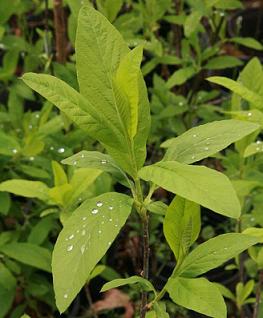 |
||||||||||||||||||||||||||||||||
|
Lastly, the flowers have a very conspicuous smell, which differs greatly between the sexes. The smell of the female plant has been likened to green watermelons or watermelon rind and even cucumbers and is described as peculiar by many writers. Perhaps vile is a more appropriate adjective for the male flowers, as they are reminiscent of cat urine. Fortunately, one must inhale deeply and be in very close proximity to be privy to this offensive aroma. It is small wonder one common name for this plant is Skunk Bush. Shrubs are either male or female (dioecious). Male flowers are more striking than the female, larger and more white. Female flowers appear greener. Said one gardener:
|
|||||||||||||||||||||||||||||||||
|
The fruit of the Indian Plum is small and an almost exact replica of a plum, which is the reason for its most common name. As they ripen, the tidy bunches of ½ fruit change in color from a rich salmon to a deep blue-black. They are quite beautiful and stand in sharp contrast to the deep green of the foliage. The fruit is flat, even acidic and chalky when under-ripe but quite mild and juicy when fully ripe. They are much relished by birds. Habitat and Range: Indian Plum is found west of the Cascade Mountains between the farthest southwestern areas of British Columbia and south to California. It is found at lower elevations, between 0 5,600 feet and is generally found in shaded areas with sandy topsoil and heavy clay subsoil. It grows in USDA zones 8 9, in areas with an average yearly rainfall of 36 300. |
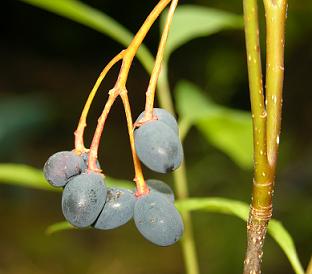 |
||||||||||||||||||||||||||||||||
|
Ornamental Value: Indian Plum is a beautiful shrub, with its gracefully arching branches and unique flowering habits. The new foliage, a vibrant lime green is glorious as is the maturing fruit, noteworthy in its abundance and its many shades. |
|||||||||||||||||||||||||||||||||
|
Native Plant Gardening/Wildlife Habitat: Indian Plum attracts many birds. Indeed, finding ripe fruit to snack upon is a challenge as the eager birds frequently raid the bushes long before the fruit has fully matured. Restoration and Mitigation Value: Indian Plum is an invaluable in restoration projects. Not only will it thrive in deep shade, but also it will grow on difficult sites, such as north-facing slopes. Furthermore, it is tolerant of polluted soils. If you live near a highly trafficked area, a construction or industrial area or a golf course, consider planting a hedgerow of Indian Plum. Historical/Cultural uses: First Nations people used the Indian Plum as a food and medicine. The fruits were eaten fresh or dried for winter use. Several customs were connected to the eating of Indian Plum. One was that water was forbidden while eating them, although Grease (the oil of a small fish and a food staple of many of the First Nations people of the Pacific Northwest) was allowed. There was, in fact, an entire feast dedicated to the Indian Plum that was held during the winter dance season. During this feast, guests were called four times to dance. |
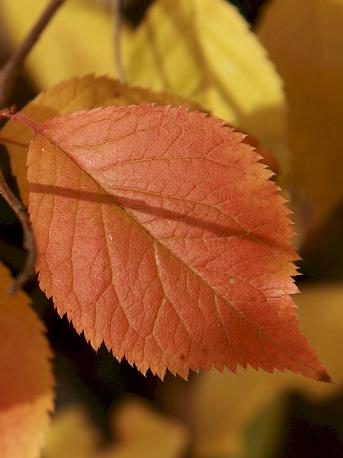 |
||||||||||||||||||||||||||||||||
|
A decoction of the bark of Indian Plum was used to treat tuberculosis. The plant was also used to promote healing. It was chewed, burnt and then mixed with oil and applied to wounds and sores. |
|||||||||||||||||||||||||||||||||
|
Edible and Medicinal Uses: Before consuming any wild plant be absolutely certain that you have properly identified the plant. It is best to observe a plant through several seasons and stages of growth to be certain you have the correct plant. Use extreme caution in preparation as many wild plants have toxic parts (for example, the roots may be poisonous but not the leaves of some species) and check with a health care professional before using any wild plant medicinally. Lastly, do not over-harvest: leave ample fruit for reseeding and wildlife food. Respect that native plants are already in extreme competition with both human development and such troublesome invasive species as Scotch Broom (Cystisus scoparius), Gorse (Ulex europaeus) and Purple Loosestrife (Lysimachia salicaria). By depleting an area of a native species, you are essentially inviting an invasive species to establish itself. Pick fruit or leaves in areas where there are large enough numbers of the plant to support harvesting. |
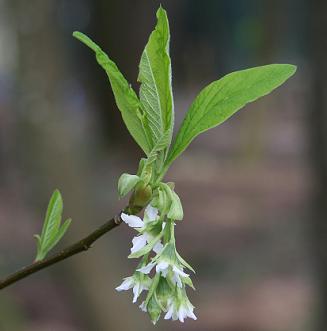 |
||||||||||||||||||||||||||||||||
|
While the fruit of the Indian Plum is edible, there is some concern that it may contain hydrogen cyanide. Be cautious and consume fruit in small quantities. Also, for flavors sake, eat only the very ripe fruit! Propagation Techniques: Seeds can be collected and sown outdoors in the fall or spring. Germination of spring-sown seed is more successful if the seeds are first given cold treatment or stratified. Place seeds in a bag of moist peat moss and store them in the freezer for four months. Half-ripe cuttings, taken in the summer are often successful. Suckers can also be removed from the parent plant during the winter months, and will survive on their own provided great care is taken. Plant Associations: Indian Plum is often found growing alongside Red Elderberry (Sambucus racemosa), Red Osier Dogwood (Cornus sericea [stolonifera]), Stinging nettle (Uritica dioica), Vanilla Leaf (Achlys triphylla), Foamflower (Tiarella spp.) and Salal (Gaultheria shallon). Foamflower is an exceptionally complementary partner to the Indian Plum: the latter flowers early and its branches cascade down, while the foamflower blooms in the early summer and for a prolonged period and grows erect and tidy, its white plumes an accent to the dark plums. |
|||||||||||||||||||||||||||||||||
|
|||||||||||||||||||||||||||||||||
|
Photos We Share!
|
|||||||||||||||||||||||||||||||||
|
Bibliography: Thank you to the
following references for their invaluable information:
|
|||||||||||||||||||||||||||||||||
|